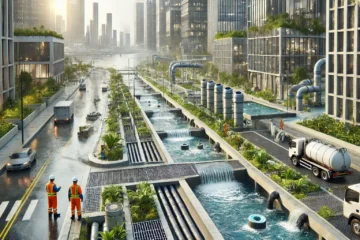Updates in Oil and Gas Pipelines: Trends, Innovations, and Challenges
Oil and gas pipelines are the lifelines of the energy industry, enabling the efficient and cost-effective transportation of hydrocarbons over vast distances. With evolving technologies, stricter regulations, and a growing focus on sustainability, the pipeline sector is undergoing significant transformation. This blog explores recent updates, technological advancements, challenges, and future trends in oil and gas pipeline systems.
Recent Developments in Oil and Gas Pipelines
- Increased Demand for Natural Gas Pipelines
- Natural gas is gaining traction as a cleaner energy source compared to coal and oil. This has led to investments in expanding and modernizing natural gas pipeline networks worldwide.
- Expansion into New Regions
- Large-scale projects are focusing on connecting untapped reserves in regions such as Africa, the Middle East, and Southeast Asia to global markets.
- Digital Transformation
- The integration of digital technologies like IoT (Internet of Things), AI (Artificial Intelligence), and Big Data is revolutionizing pipeline monitoring and management.
- Cross-Border Collaboration
- Major pipeline projects like Nord Stream 2 and the Trans-Anatolian Natural Gas Pipeline (TANAP) demonstrate the increasing importance of international partnerships in energy transportation.
- Sustainability Initiatives
- Companies are adopting greener pipeline technologies, such as reducing methane emissions and integrating renewable energy sources into operations.
Technological Advancements in Pipelines
- Pipeline Monitoring Systems
- Advanced sensors and IoT devices are now widely used to detect leaks, monitor pressure, and ensure pipeline integrity in real time.
- AI-Powered Predictive Maintenance
- AI algorithms analyze historical and real-time data to predict potential failures, reducing downtime and maintenance costs.
- Smart Pipelines
- Integration of smart technologies allows automated control systems to optimize flow rates, detect abnormalities, and improve operational efficiency.
- Corrosion-Resistant Materials
- Research and deployment of advanced materials, such as composite pipes and high-strength steel, enhance the longevity and safety of pipelines.
- Remote Sensing and Drones
- Drones equipped with thermal imaging cameras and LiDAR technology are being deployed for pipeline inspections in remote or hazardous areas.
Challenges in the Oil and Gas Pipeline Sector
- Aging Infrastructure
- Many pipelines, particularly in developed countries, are decades old and require extensive maintenance or replacement.
- Environmental Concerns
- Pipeline projects often face opposition due to concerns over ecological disruption, water contamination, and greenhouse gas emissions.
- Cybersecurity Threats
- Increased digitalization has made pipelines vulnerable to cyberattacks, such as the Colonial Pipeline ransomware attack in 2021.
- Regulatory Compliance
- Stringent regulations regarding safety, emissions, and environmental impact add complexity to pipeline planning and operations.
- Geopolitical Risks
- Cross-border pipelines are often subject to political tensions, trade disputes, and economic sanctions.
Case Studies of Recent Pipeline Projects
- Nord Stream 2 (Europe)
- A major pipeline transporting natural gas from Russia to Europe, emphasizing efficiency and reducing transit costs. However, it faced geopolitical controversies and sanctions.
- Permian Highway Pipeline (USA)
- A significant project to transport natural gas from the Permian Basin, focusing on meeting growing energy demands in Texas and beyond.
- East Africa Crude Oil Pipeline (EACOP)
- Connecting Uganda’s oil reserves to Tanzania’s coast, this project has sparked debates over environmental impacts and benefits to local communities.
Sustainability in Pipeline Operations
- Methane Emission Reduction
- Advanced detection systems are used to locate and fix methane leaks, minimizing greenhouse gas emissions.
- Renewable Energy Integration
- Solar and wind energy are increasingly used to power pipeline pumping stations.
- Carbon Capture and Storage (CCS)
- Pipelines are being adapted to transport captured CO2 to storage facilities, supporting carbon reduction efforts.
- Eco-Friendly Construction Practices
- Techniques such as horizontal directional drilling (HDD) reduce surface disruption during pipeline installation.
Future Trends in Oil and Gas Pipelines
- Hydrogen-Ready Pipelines
- With the rise of hydrogen as a clean energy carrier, existing pipelines are being adapted to transport hydrogen blends or pure hydrogen.
- Decarbonization Efforts
- Companies are investing in technologies to reduce the carbon footprint of pipeline operations, aligning with global climate goals.
- Blockchain Technology
- Blockchain is being explored for secure and transparent tracking of oil and gas shipments through pipelines.
- Enhanced Cybersecurity Measures
- Investments in robust cybersecurity frameworks are critical to protecting pipeline infrastructure from potential cyber threats.
- Modular Pipelines
- Portable and modular pipeline designs are emerging as a solution for short-term or temporary energy transportation needs.
Conclusion
The oil and gas pipeline sector is at a crossroads, balancing the need for expansion and modernization with sustainability and safety concerns. Technological advancements are reshaping the industry, offering solutions to long-standing challenges and paving the way for a more efficient and environmentally conscious future. By embracing innovation and collaboration, the pipeline industry can continue to play a vital role in global energy supply while aligning with the world’s evolving energy landscape.


